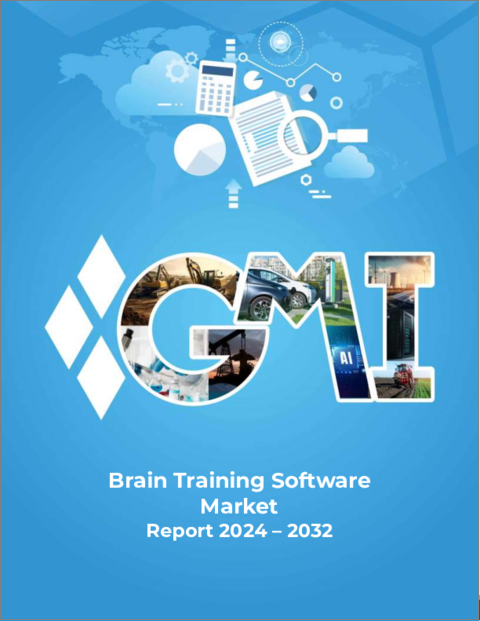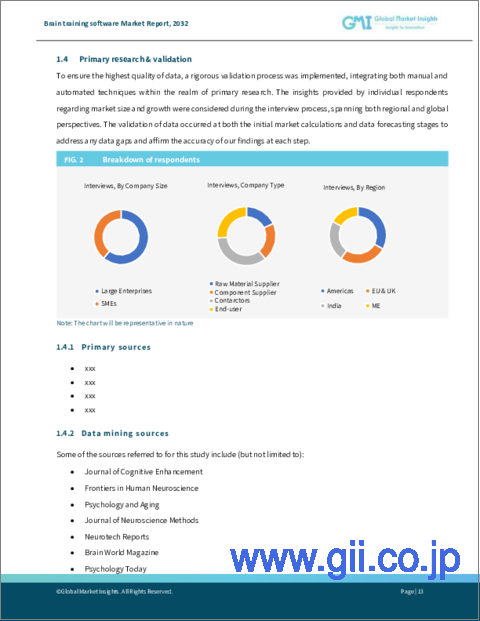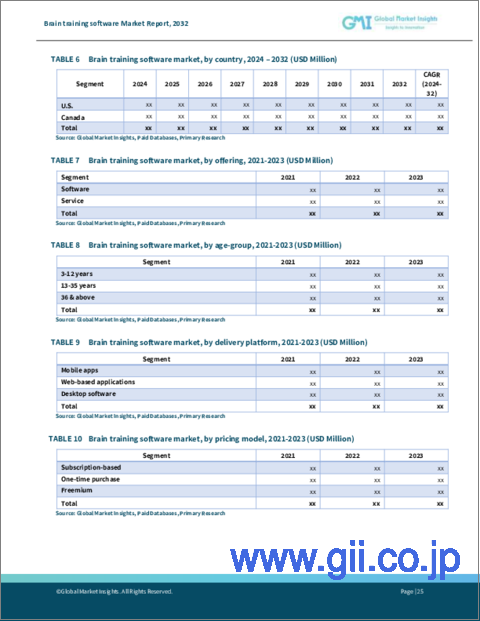|
|
市場調査レポート
商品コード
1524316
脳トレーニングソフトウェアの市場規模:提供別、年齢層別、提供プラットフォーム別、価格モデル別、最終用途別、予測、2024年~2032年Brain Training Software Market Size - By Offerings, By Age Group, By Delivery Platform, By Pricing Model, By End Use & Forecast, 2024 - 2032 |
||||||
カスタマイズ可能
|
|||||||
| 脳トレーニングソフトウェアの市場規模:提供別、年齢層別、提供プラットフォーム別、価格モデル別、最終用途別、予測、2024年~2032年 |
|
出版日: 2024年04月17日
発行: Global Market Insights Inc.
ページ情報: 英文 280 Pages
納期: 2~3営業日
|
- 全表示
- 概要
- 目次
世界の脳トレーニングソフトウェア市場は、インターネットとスマートフォンの普及により、2024年から2032年にかけて20%以上のCAGRを示すと思われます。
EUの2030年目標によると、成人の80%が基本的なデジタルスキルを持つべきです。2023年には90%以上のEU市民が毎週インターネットを利用しているにもかかわらず、基本的なデジタルスキル以上の能力を獲得しているのはわずか56%にすぎず、デジタルスキル開発イニシアチブの継続的な必要性が浮き彫りになっています。デジタル化の進展は、認知能力を高めるための便利で利用しやすい方法を提供する脳トレーニングソフトウェアの普及を後押ししています。日常生活の多くの側面がデジタル化されるにつれて、個人は精神的な鋭敏さを高めるためのデジタルソリューションを求めています。
脳トレーニングソフトウェアは、いつでもどこでもアクセスできる柔軟なオンデマンド認知エクササイズを提供することで、この動向に適合しています。このアクセシビリティは、多忙な社会人から、頭の冴えを維持したい高齢者まで、幅広い層にアピールします。また、デジタル形式は、個人に合わせた学習体験と継続的な改善を可能にし、健康とウェルネスにおける技術主導のソリューションに対する現代の嗜好に合致しています。
2032年までの脳トレーニングソフトウェア市場のCAGRは、3~12歳の年齢層で堅調に推移します。早期認知発達の重要性が認識されつつあるため、脳トレーニングソフトウェアの需要は3~12歳の子供たちの間で大幅に増加しています。親や教育者は、重要な発達段階における学習、記憶保持、問題解決能力をサポートする効果的なツールを求めています。脳トレソフトは、楽しくインタラクティブな方法で認知機能を刺激する、魅力的で年齢に応じたアクティビティを提供し、子供とその保護者の両方にアピールします。この分野の成長には、教育の成果を向上させ、競争が激化する世界で学業で成功するための準備を整えたいという願望があり、幼児教育向けのデジタル・ソリューションを活用しています。
サービス部門は、企業のウェルネス・プログラム、教育機関、ヘルスケア施設における多様なニーズに対応できることから、2032年までに脳トレーニングソフトウェア市場で十分なシェアを確保すると思われます。これらの分野では、生産性の向上、学習成果の向上、患者のリハビリテーションにおける認知機能強化ツールの価値がますます認識されるようになっています。脳トレーニングソフトウェアは、特定の組織や教育目標に合わせてカスタマイズ可能なソリューションを提供するため、従業員、学生、患者を問わず、認知能力や精神的敏捷性を高めるための汎用性の高い選択肢となります。この適応性は、サービス指向の環境における効果的でスケーラブルなソリューションに対する需要の高まりに対応しています。
アジア太平洋地域の脳トレーニングソフトウェア市場は、予測期間中に有望なCAGRを示すと思われます。アジア太平洋地域では、急速な都市化、技術導入、認知健康に対する意識の高まりにより、脳トレーニングソフトウェアの需要が急増しています。アジア太平洋諸国では、デジタルリテラシーとスマートフォンの普及率が急上昇しており、より多くの人々が脳トレーニングアプリにアクセスできるようになっています。可処分所得の増加と中間層の増加は、健康とウェルネスへの積極的なアプローチの一環として、認知機能強化ツールを優先しています。教育競争力と生涯学習の追求は、記憶力、集中力、認知能力の向上を約束するデジタル・ソリューションを個人も教育機関も同様に受け入れることで、普及を促しています。
目次
第1章 調査手法と調査範囲
第2章 エグゼクティブサマリー
第3章 業界洞察
- エコシステム分析
- サプライヤーの状況
- ソフトウェアプロバイダー
- テクノロジープロバイダー
- サービスプロバイダー
- 利益率分析
- 技術とイノベーションの展望
- 特許分析
- 主要ニュース&イニシアチブ
- 規制状況
- 影響要因
- 促進要因
- 認知健康への関心の高まり
- 脳トレモジュールの技術的進歩の高まり
- デジタル機器へのアクセシビリティの向上
- 脳トレーニングソフトウェアによって達成される労働力の生産性とパフォーマンス
- 業界の潜在的リスク&課題
- 科学的妥当性の課題
- 促進要因
- 成長可能性分析
- ポーター分析
- PESTEL分析
第4章 競合情勢
- イントロダクション
- 企業シェア分析
- 競合のポジショニング・マトリックス
- 戦略展望マトリックス
第5章 市場推計・予測:提供別、2021年~2032年
- 主要動向
- ソフトウェア
- 認知スキル向上
- 記憶力向上
- 注意力・集中力トレーニング
- 問題解決と推論
- 言語学習
- 情緒知能の発達
- サービス
- トレーニング&サポート
- コンサルティングサービス
第6章 市場推計・予測:年齢層別、2021年~2032年
- 主要動向
- 3~12歳
- 13~35歳
- 36歳以上
第7章 市場推計・予測:提供プラットフォーム別、2021年~2032年
- 主要動向
- モバイルアプリ
- ウェブベースのアプリケーション
- デスクトップソフトウェア
第8章 市場推計・予測:価格モデル別、2021年~2032年
- 主要動向
- サブスクリプション型
- 一括購入型
- フリーミアム
第9章 市場推計・予測:エンドユーザー別、2021年~2032年
- 主要動向
- ヘルスケア
- 教育
- 企業研修
- スポーツ&アスレチック
- ゲーム&エンターテイメント
- その他
第10章 市場推計・予測:地域別、2021年~2032年
- 主要動向
- 北米
- 米国
- カナダ
- 欧州
- 英国
- ドイツ
- フランス
- イタリア
- スペイン
- ロシア
- 北欧
- その他欧州
- アジア太平洋
- 中国
- インド
- 日本
- 韓国
- ニュージーランド
- 東南アジア
- その他アジア太平洋地域
- ラテンアメリカ
- ブラジル
- メキシコ
- アルゼンチン
- その他ラテンアメリカ
- 中東・アフリカ
- 南アフリカ
- サウジアラビア
- アラブ首長国連邦
- その他中東・アフリカ
第11章 企業プロファイル
- Akili Interactive Labs
- Braingle
- BrainWorkshop
- Cogmed
- CogniFit
- Creyos
- Elevate
- Happify
- HAPPYneuron, Inc
- Houghton Mifflin Harcourt
- Lumos Labs
- Memorado
- MentalUP
- My Brain Trainer
- Neuronation
- Nintendo
- Posit Science
- Sens.ai
- Take-Two Interactive
- ThinkFast
Global Brain Training Software Market will exhibit over 20% CAGR between 2024 and 2032, ushered by the penetration of the internet and smartphones. According to the EU's 2030 target, 80% of adults should possess basic digital skills. Despite over 90% of EU citizens using the internet weekly in 2023, only 56% have attained basic or higher digital proficiency, highlighting the ongoing need for digital skill development initiatives. Increased digitization has propelled the adoption of brain training software, offering a convenient and accessible method to boost cognitive abilities. As more aspects of daily life become digitized, individuals seek digital solutions for enhancing mental acuity.
Brain training software fits this trend by providing flexible, on-demand cognitive exercises that can be accessed anytime, anywhere. This accessibility appeals to a broad demographic, from busy professionals to older adults looking to maintain mental sharpness. The digital format also allows for personalized learning experiences and continuous improvement, aligning with modern preferences for tech-driven solutions in health and wellness.
The overall brain training software industry is segmented based on offerings, age group, delivery platform, pricing model, end use, and region.
The age group segment of 3-12 years will indicate a robust CAGR in the brain training software market through 2032. The demand for brain training software is rising significantly among children aged 3-12 years due to increasing recognition of the importance of early cognitive development. Parents and educators are seeking effective tools to support learning, memory retention, and problem-solving skills during critical developmental stages. Brain training software offers engaging and age-appropriate activities that stimulate cognitive functions in a fun and interactive manner, appealing to both children and their caregivers. This segment's growth is fueled by a desire to enhance educational outcomes and prepare young minds for academic success in an increasingly competitive world, leveraging digital solutions for early childhood development.
The services segment will secure an ample brain training software market share by 2032, owing to its ability to cater to diverse needs within corporate wellness programs, educational institutions, and healthcare facilities. These sectors increasingly recognize the value of cognitive enhancement tools in improving productivity, learning outcomes, and patient rehabilitation. Brain training software offers customizable solutions that can be tailored to specific organizational or educational goals, making it a versatile choice for enhancing cognitive abilities and mental agility among employees, students, and patients alike. This adaptability meets the growing demand for effective, scalable solutions in service-oriented environments.
Asia Pacific brain training software market will show a promising CAGR during the forecast period. The demand for brain training software is burgeoning in Asia Pacific due to rapid urbanization, technological adoption, and increasing awareness of cognitive health. Countries in Asia Pacific are witnessing a surge in digital literacy and smartphone penetration, making brain training apps accessible to a broader population. Rising disposable incomes and a growing middle class prioritize cognitive enhancement tools as part of a proactive approach to health and wellness. Educational competitiveness and the pursuit of lifelong learning usher adoption, with individuals and institutions alike embracing digital solutions that promise to improve memory, concentration, and cognitive abilities.
Table of Contents
Chapter 1 Methodology & Scope
- 1.1 Research design
- 1.1.1 Research approach
- 1.1.2 Data collection methods
- 1.2 Base estimates and calculations
- 1.2.1 Base year calculation
- 1.2.2 Key trends for market estimates
- 1.3 Forecast model
- 1.4 Primary research & validation
- 1.4.1 Primary sources
- 1.4.2 Data mining sources
- 1.5 Market definitions
Chapter 2 Executive Summary
- 2.1 Industry 360° synopsis, 2021-2032
Chapter 3 Industry Insights
- 3.1 Industry ecosystem analysis
- 3.2 Supplier landscape
- 3.2.1 Software providers
- 3.2.2 Technology providers
- 3.2.3 Service providers
- 3.3 Profit margin analysis
- 3.4 Technology & innovation landscape
- 3.5 Patent analysis
- 3.6 Key news & initiatives
- 3.7 Regulatory landscape
- 3.8 Impact forces
- 3.8.1 Growth drivers
- 3.8.1.1 Growing interest in cognitive health
- 3.8.1.2 Growing technological advancements in brain training modules
- 3.8.1.3 Increased accessibility to digital devices
- 3.8.1.4 Workforce productivity and performance achieved by brain training software
- 3.8.2 Industry pitfalls & challenges
- 3.8.2.1 Scientific validity challenges
- 3.8.1 Growth drivers
- 3.9 Growth potential analysis
- 3.10 Porter's analysis
- 3.11 PESTEL analysis
Chapter 4 Competitive Landscape, 2023
- 4.1 Introduction
- 4.2 Company market share analysis
- 4.3 Competitive positioning matrix
- 4.4 Strategic outlook matrix
Chapter 5 Market Estimates & Forecast, By Offerings, 2021-2032 ($ Bn)
- 5.1 Key trends
- 5.2 Software
- 5.2.1 Cognitive skills enhancement
- 5.2.2 Memory improvement
- 5.2.3 Attention and focus training
- 5.2.4 Problem-solving and reasoning
- 5.2.5 Language learning
- 5.2.6 Emotional intelligence development
- 5.3 Services
- 5.3.1 Training & support
- 5.3.2 Consulting services
Chapter 6 Market Estimate & Forecast, By Age Group, 2021-2032 ($ Bn)
- 6.1 Key trends
- 6.2 3-12 years
- 6.3 13-35 years
- 6.4 36 & above
Chapter 7 Market Estimates & Forecast, By Delivery Platform, 2021-2032 ($ Bn)
- 7.1 Key trends
- 7.2 Mobile apps
- 7.3 Web-based application
- 7.4 Desktop software
Chapter 8 Market Estimates & Forecast, By Pricing Model, 2021-2032 ($ Bn)
- 8.1 Key trends
- 8.2 Subscription-based
- 8.3 One-time purchase
- 8.4 Freemium
Chapter 9 Market Estimates & Forecast, By End-Use, 2021-2032 ($ Bn)
- 9.1 Key trends
- 9.2 Healthcare
- 9.3 Education
- 9.4 Corporate training
- 9.5 Sports & athletics
- 9.6 Gaming & entertainment
- 9.7 Others
Chapter 10 Market Estimates & Forecast, By Region, 2021-2032 ($ Bn)
- 10.1 Key trends
- 10.2 North America
- 10.2.1 U.S.
- 10.2.2 Canada
- 10.3 Europe
- 10.3.1 UK
- 10.3.2 Germany
- 10.3.3 France
- 10.3.4 Italy
- 10.3.5 Spain
- 10.3.6 Russia
- 10.3.7 Nordics
- 10.3.8 Rest of Europe
- 10.4 Asia Pacific
- 10.4.1 China
- 10.4.2 India
- 10.4.3 Japan
- 10.4.4 South Korea
- 10.4.5 ANZ
- 10.4.6 Southeast Asia
- 10.4.7 Rest of Asia Pacific
- 10.5 Latin America
- 10.5.1 Brazil
- 10.5.2 Mexico
- 10.5.3 Argentina
- 10.5.4 Rest of Latin America
- 10.6 MEA
- 10.6.1 South Africa
- 10.6.2 Saudi Arabia
- 10.6.3 UAE
- 10.6.4 Rest of MEA
Chapter 11 Company Profiles
- 11.1 Akili Interactive Labs
- 11.2 Braingle
- 11.3 BrainWorkshop
- 11.4 Cogmed
- 11.5 CogniFit
- 11.6 Creyos
- 11.7 Elevate
- 11.8 Happify
- 11.9 HAPPYneuron, Inc
- 11.10 Houghton Mifflin Harcourt
- 11.11 Lumos Labs
- 11.12 Memorado
- 11.13 MentalUP
- 11.14 My Brain Trainer
- 11.15 Neuronation
- 11.16 Nintendo
- 11.17 Posit Science
- 11.18 Sens.ai
- 11.19 Take-Two Interactive
- 11.20 ThinkFast





